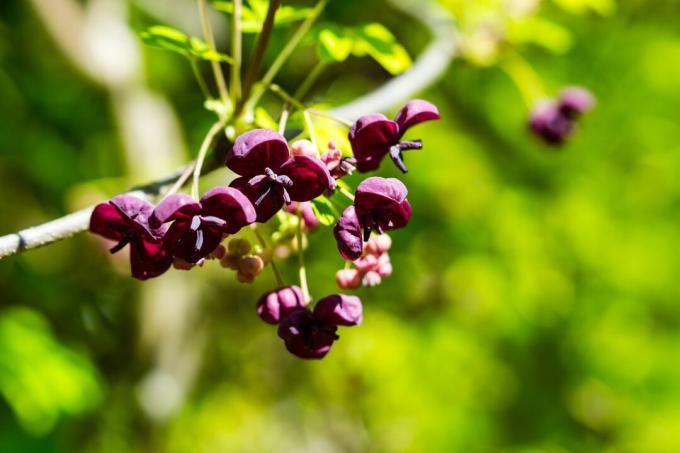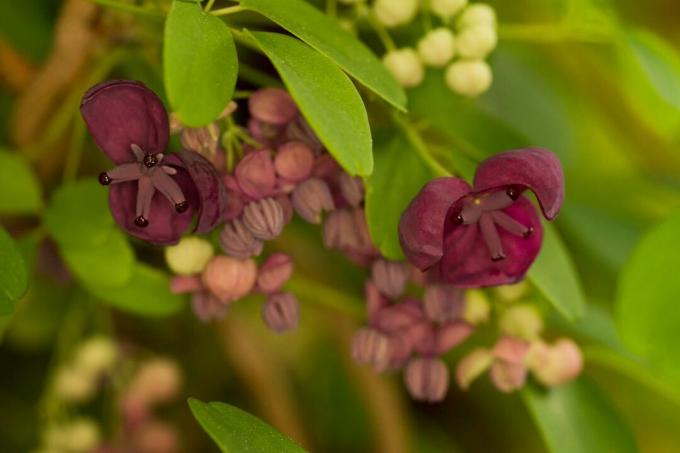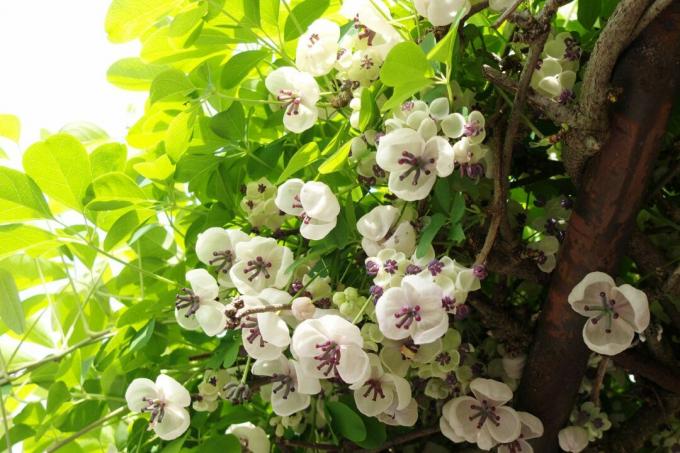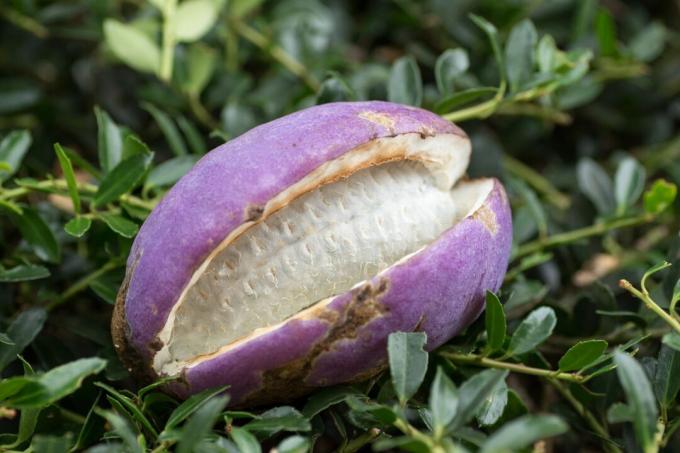Akebie, also known as chocolate wine or climbing cucumber, is very popular as a decorative climbing plant. We reveal what you should consider when planting chocolate wine and give tips on caring for the Akebie.

Are you wondering what is meant by chocolate wine? There is a fascinating climbing plant behind this name. It owes its name to the enchanting scent of its flowers. We will introduce you to this beauty and show you how soon an Akebie can also decorate your garden.
contents
- Akebie: origin and characteristics
- The most beautiful varieties of climbing cucumber
- Planting chocolate wine: location, timing and procedure
- Caring for chocolate wine: everything for cutting, pouring and fertilizing
- Increase Akebie
- Are Akebien friendly to bees?
- Chocolate wine fruits: edible or poisonous?
Akebie: origin and characteristics
Akebie (Akebia) is a genus of plants that consists of several species. The Finger-leaved Akebia (
Akebia quinata) is available as an ornamental plant in Europe. It is also called chocolate wine because of the sweet scent of its flowers, which is reminiscent of vanilla and chocolate. The shape of the fruit resembles a cucumber, which is why it was given the name climbing cucumber. The Akebia comes from the mountain forests of East Asia and is common in China and Japan. The Akebie enchants with its mostly dark green leaf dress, which only falls off in particularly cold winters, and wonderfully fragrant flowers. The fruits of the climbing cucumber, which is usually planted as an ornamental plant, are edible and make them an exciting plant even in autumn. Once you've replanted the Akebia, you should be patient. The Akebia grows slowly in the first two years and only shows its dense foliage in the third year. After about five years you will be able to enjoy the wonderful scent of the flowers for the first time from April to May. But patience is worth it. The Akebie is a rarity and an eye-catcher in your garden. The plant grows on a climbing aid, such as a pergola or as a facade greening up to ten meters in height.
Tip: On closer inspection, you can see female and male flowers, which are differently colored in most varieties.
The most beautiful varieties of climbing cucumber
The different varieties of the finger-leaved acebia, also called climbing cucumber, are characterized by the different colors of the flowers and leaves. Akebia quinata "Silver Bells" presents white male flowers with dark purple stamens and pink colored female flowers. The variety Akebia quinata ‘Alba‘ has white female and male flowers, whereas the cultivar Akebia quinata ‘Variegata’ stands out with its white speckled leaves.
Planting chocolate wine: location, timing and procedure
Chocolate wine only feels good as a climbing plant outdoors. For the heat-loving plant, you should choose a sunny to partially shaded location protected from the wind. Although the chocolate wine comes from the subtropical region, it is hardy. At temperatures below -10 ° C, the root area should be covered with leaves or something similar.

The soil can be sandy to loamy, but it should definitely be humus, as the Akebia only blooms with a good supply of nutrients. The Akebia is best planted in spring to ensure that it will grow until the first winter. With little sun and occasional rain, it has the optimal conditions for growing.
If you want to use the Akebie as a facade greening, you should dig the planting hole about half a meter from the wall to give the roots enough space. Since Akebia form underground shoots for reproduction, so-called rhizomes, we recommend a rhizome barrier. To do this, you can remove the bottom of a bucket or plastic pot with a diameter of about one meter and place the ring in the equally large planting hole. The top of the ring should stay just above the surface of the earth. For a better development of the chocolate wine we recommend the planting hole with a mixture of the soil of the location and a peat-free potting soil like ours Plantura organic potting soil to fill. You can now plant the plant in the middle of the hole, press it down well and water it abundantly. You should pay attention to a good water supply, especially in the next three weeks. To guide the chocolate wine to your support or pergola, it is best to stretch several ropes to your desired location.
How do I plant chocolate wine?
- sunny and sheltered location
- humus soil for a good supply of nutrients with peat-free potting soil like ours Plantura organic potting soil
- Planting hole with a diameter of one meter
- Install the rhizome barrier in the planting hole
- make sure there is a good water supply for the first three weeks

Caring for chocolate wine: everything for cutting, pouring and fertilizing
The chocolate wine is a woody climber that tends to shed in the lower area. To prevent this, individual shoots can be cut back vigorously. Avoid shortening all of the shoots at the same time so as not to weaken the plant too much. Unwanted shoots can be removed right after flowering. In the first three weeks after planting and the following summer, care should be taken to ensure a good water supply, as the plant does not yet have deep roots. In the following years, the plant should do without additional watering. In order to promote flower formation, we recommend providing the Akebia with an organic fertilizer, especially with sufficient potassium. Our Plantura organic flower & balcony fertilizer. This strengthens and vitalises the plant with all the valuable nutrients. This makes the Akebia less susceptible to pests and diseases.
tip: The Akebia is less susceptible to pests or plant diseases, which makes it an easy-care eye-catcher in your garden.
Increase Akebie
The Akebia can be propagated by sowing the seeds about five millimeters in size or by cuttings. Due to the very slow development of the seedlings, we recommend propagating via cuttings. These offshoots often form on their own. As soon as a shoot rests on the ground, it begins to take root at the contact point. This can also be done in a targeted manner by bending a shoot with a stone on the ground and weighing it down. You can always check whether the shoot of the climbing cucumber has already grown in place and has therefore taken root. If this is the case, you can cut the shoot to the mother plant. After a few weeks, you can dig up the offshoot and plant the climbing cucumber in a different location.
Are Akebien friendly to bees?
The flowers of the Akebia are of little interest to bees because the flowers do not contain any nectar. We therefore recommend sowing a bed with a flower mixture around the Akebia, in which bees and others can be found Beneficial insects feel good. Our Beneficial magnet is a seed mix that enables you to create such a paradise for beneficial insects in next to no time.
Chocolate wine fruits: edible or poisonous?
The fruits of chocolate wine are not poisonous, but edible and are considered a delicacy in Asia. The leaves of chocolate wine are also non-toxic and are even used as tea in some regions of Asia. Especially in warm regions of Germany, where, for example, wine is also grown, you can expect to be able to harvest fruits from your climbing cucumber in October. The cucumber-shaped fruits are five to 12 centimeters long, dark brown and coated with a layer of wax, depending on the variety. When fully ripe, the fruits burst open on their own and reveal a whitish, slightly sweet flesh.

In addition to the exotic Akebie, there are also numerous exciting, insect-friendly climbing plantsthat can decorate your pergola or house facade.



